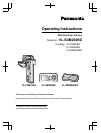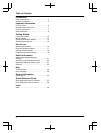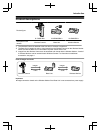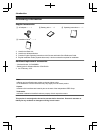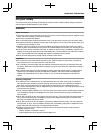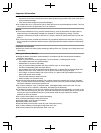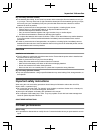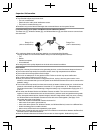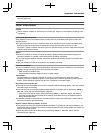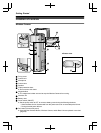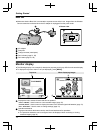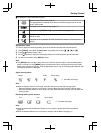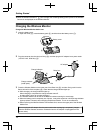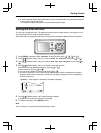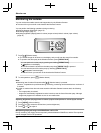
R When power fails, this unit cannot be used.
R The recorded images may be lost when:
– The unit is mishandled.
– Electric shock or radio wave interference occurs.
– The power is turned off during use.
R Panasonic may not be liable for damages due to external factors such as power failures.
Location/avoiding noise (Base Unit/Wireless Camera/Wireless Monitor)
The Base Unit (A), Wireless Camera (B), and Wireless Monitor (C) use radio waves to communicate
with each other.
Range 70 m
(with no obstructions)
A
C
B
Range 70 m
(with no obstructions)
R For maximum distance and noise-free operation, we recommend the following:
Placing the Base Unit and Wireless Monitor away from electrical appliances such as:
– TVs
– Radios
– Personal computers
– Air conditioners
R Coverage and voice quality depends on the local environmental conditions.
Environment
R Keep the unit away from electrical noise generating devices, such as fluorescent lamps and motors.
R The unit should be kept away from excessive smoke, dust, high temperature and vibration.
R The unit should not be exposed to direct sunlight.
R The unit is not waterproof. Do not get the unit wet. Failure to do this may cause malfunction.
R Do not place heavy objects on top of the unit.
R When you leave the unit unused for a long period of time, unplug it from the power outlet. In this
situation, we recommend that you turn the power for the Wireless Camera off in order to conserve the
batteries’ energy.
R The unit should be kept away from heat sources such as heaters, kitchen stoves, etc. It should not be
placed in rooms where the temperature is less than 5 °C or greater than 40 °C. Damp basements
should also be avoided. To avoid damage, charge the battery only in temperatures ranging from 5 °C
to 40 °C.
R Even when the Wireless Monitor and Wireless Camera are within 70 m and not used too close
together, if there are obstructions such as the ones below, problems such as signals becoming weak,
noise, interrupted transmissions, distorted images, and slow image refresh rates may occur, causing
the Wireless Monitor and Wireless Camera to not be able to be used together. (See page 13 for
information about the signal display.)
– walls with insulation material that contains aluminum foil
– walls made of concrete or galvanized iron
– when each device (Base Unit, Wireless Camera, and Wireless Monitor) is used on a different floor
– double insulating glass or metallic shutters
– places where several walls are separated by open space
R Some types of hearing aids may receive noise from wireless communications between the Base Unit,
Wireless Camera, and Wireless Monitor.
R When the Wireless Monitor and Wireless Camera are too close together, feedback may occur.
8
Important Information



